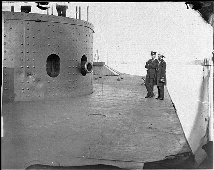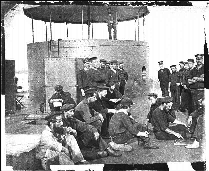

|
|

The USS Monitor
 Constructed in 1861-1862 at the Continental Ship Yard in Greepoint Brooklyn in 101 daysJohn Ericsson, a New York resident in the 1860's, was one of the unsung inventors of his day. He invented air compressors, boilers, engines, locomotives, naval guns and a prototype for the screw propeller...and was a wraith to Naval Brass for much of his life. He designed a Man of War class naval vessel called the Princeton with partner John S Stockton. The Princeton sported a prototype twelve caliber gun, the biggest ever used up to this time, designed by Ericsson, but altered by his partner's in the prototype. Stockton left out critical reinforcement. With the Secretary of Navy on board, under the Tyler administration, while demonstrating the new gun, it exploded, killing both Secretary of State Abel P. Ushur and Secretary of the Navy Thomas Gilmer. President Tyler was on board below deck, but escaped death. So when Ericsson described his invention of a revolutionary new boat designed for Napoleon the 3rd with a revolving turret holding eleven inch guns...no one was listening. All of this changed on March 8th, 1862 when the Merrimac, renamed the Virginia, came out of Norfolk Virginia. The Merrimac had been refitted with steel plating, and attacked and destroyed the Federal Blockade at Hampton Roads, a critical naval port on the Virginia, North Carolina boarder. Intelligence in Washington warned of the impending rebuilding of the Merrimac. Gideon Wells, then Secretary of the Navy advertised for plans of an iron clad vessel. Ericsson's designs could no long be ignored by the Navy. And despite being turned down from Navy Brass, Secretary of State, William Henry Steward, brought the plans of the Monitor to President Lincoln. Above the objections of Navy Brass, Lincoln admired the plan and declared, "Well, as the girl said when she put her leg in the stocking, I think there is something in it. The Navy was forced to consider Ericsson, and offered $275,000 if the government received delivery in 100 days. It was considered impossible to build in that time frame, but the Navy Brass who wanted to scuttle the plans didn't completely comprehend the tenacity and inventfulness of either Ericsson, or the shipyards and people of Brooklyn!!! The Monitor slid into the water in 101 days. It moved from the Continental Ship Yard into of the Brooklyn Navy Yard on January 30th, 1862 for delivery and some further fitting. 172 feet long, it drew 10 1/2 feet of water, possessing two 11 inch smoothbore Dahlgren guns on a revolving turret. It had devices of over 40 original patents on board. The Monitor was well beyond state of the art in it's day. On March 6, 1862, it escorted the gunboats Carrittuck and Sachem, and the tug Seth Low, for Hampton Roads. The Merrimac had just destroyed the Congress, which was burning in the ocean when the Monitor arrived. The Cumberland was sunk with only her masts visible above the water. The Merrimac expected to finish off the Minnesota the next morning, but instead the Monitor would intervene. The Monitor was strange in appearance, mostly being underwater except for the gun turret, Confederate sailors where puzzled by it's appearance. They described it as a cheese box on a raft. It had no sails, no visible guns, and no smokestack. But when the turret of the Monitor turned around and fired at the Merrimac, every naval craft in the world became immediately obsolete. For 3 1/2 hours the two iron clads battled mightily. Compared to the bulk of the Merrimac, the Monitor was light weight and very mobile. Each time the Merrimac took aim at the Monitors guns, the turret turned and showed a steel wall. The Merrimac ran aground in it's attempt to ram the Minnesota, and the Captain of the Monitor was the only Monitor casualty. Visibly damaged, the Merrimac retreated, and the Monitor ran back to protect the Minnesota, breaking off the engagement. It saved the Union Blockade. Ericsson felt that if the Navy permitted the Monitors guns to have the full charge he prescribed for the guns, the Monitor would have sunk the Merrimac in 15 minutes. The Confederates destroyed the Merrimac soon after to prevent its capture by Union forces. The Monitor, victorious in it's first battle sank in a storm off cape Cape Hatters, North Carolina. Fortynine Monitor crewmen survived. The shipwreck is a national underwater sanctuary and efforts are underway to preserve her by National Ocean Service.
Monitor Internet ResourcesNote - this page will remain open in the background while you visit any of these wonderful sitesJust close the new windows to return here, or click on the Task Bar
|